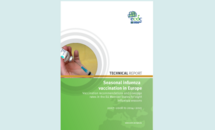Seasonal influenza vaccination in Europe – Vaccination recommendations and coverage rates for eight influenza seasons (2007–2008 to 2014–2015)
This report summarises information on seasonal influenza immunisation recommendations and vaccination coverage rates in the EU/EEA for eight influenza seasons (2007–2008 to 2014–2015).
Executive summary
In Europe, influenza occurs in regular annual epidemics in the winter season. Annual influenza epidemics are associated with high morbidity and mortality. Severe illness and complications are more common in certain risk groups, which include those with chronic medical conditions (e.g. cardiovascular, respiratory, renal and hepatic diseases; diabetes mellitus; immunosuppression due to disease or treatment; obesity; children and teenagers on long-term aspirin therapy) and individuals 65 years of age and above. The main public health intervention to prevent influenza is vaccination. To protect vulnerable individuals and reduce transmission, vaccination is also recommended for healthcare workers.
The aim of this report was to summarise the information on seasonal influenza immunisation recommendations and vaccination coverage rates in the European Union (EU) and the European Economic Area (EEA) between 2007– 08 and 2014–15, a total of eight influenza seasons.
A standardised questionnaire was developed for the first survey and made available online in January 2008. For each subsequent survey the questionnaire was amended reflecting changes in European Commission/WHO recommendations for seasonal influenza. Questionnaires were completed by experts in the EU/EEA Member States. Overall, six surveys were conducted, with eight influenza seasons covered. The participation rate was high for each survey, with only one or two countries not responding to any given survey. The United Kingdom has provided data separately for England, Northern Ireland, Scotland and Wales since 2012 (influenza season 2011–12).
All Member States recommended seasonal influenza vaccination to older age groups, with the age ranging from ≥50 to ≥65 years of age, depending on the country. Over time, a growing number of countries lowered the recommended age for adult influenza vaccination. All in all, 30 countries have lowered the recommended vaccination age at some point in time during the eight seasons covered in this report.
Six countries (Hungary, Germany, Greece, Iceland, the Netherlands and Portugal) recommended that people aged 60 years or older get vaccinated (2014–15), while for the 2007–08 season, only three (Iceland, Greece and Germany) of 27 countries made such a recommendation. Recommendations to vaccinate those 65 years or older were made by 18 countries in 2014–15, and by 19 countries in 2007–08. Two countries (Poland and Malta) recommended adult influenza vaccination for those aged 55 years and above in 2007–08 and 2014–15; Slovakia recommended vaccination for people 59 years of age or above for the 2014–15 and the 2007–08 seasons. In 2014–15, Austria, Belgium and Ireland recommended vaccination for those 50 years or older. In 2007–08, Austria and Ireland also recommended that this age group should be vaccinated.
An increase in the number of countries recommending vaccination for children was noted. Nine countries (Austria, Estonia, Finland, Malta, Latvia, Slovenia, Slovakia, Poland and United Kingdom) recommended vaccination of different age groups of children and adolescents under 18 years of age in the 2014–15 influenza season; for the 2007–08 season, only six countries did so.
Similarly, an increase in the number of countries recommending influenza vaccine for healthcare workers (HCWs) was observed. Of 30 responding Member States, 29 recommended influenza vaccinations for HCWs in 2014–15; 24 of these had recommendations in place to vaccinate all HCWs; four recommended vaccination only for certain HCWs. In Northern Ireland and Scotland, vaccine was offered to all HCWs, while England and Wales recommended that only HCWs in direct contact with patients should be vaccinated. Of the 27 responding countries, 22 recommended that HCWs should be vaccinated for the 2007–08 influenza season.
All Member States recommended seasonal influenza vaccine for people with immunosuppression due to disease or treatment, metabolic disorders, chronic pulmonary diseases, cardiovascular diseases and renal diseases for six of the eight influenza seasons covered in this report. The number of countries that recommended influenza vaccination for people with morbid obesity increased (nine Member States in 2010–11, 19 in 2014–15). Also on the increase are vaccination recommendations for hepatic diseases (15 Member States in 2007–08, 27 in 2014–15). Twenty-six Member States recommended vaccination for people with neurological diseases in 2014–15 (2010–11: 19 Member States). Ten Member States recommended the vaccination of pregnant women in 2010–11; in 2014– 15, 27 Member States recommended influenza vaccination for pregnant women.
A decrease in the number of Member States recommending influenza vaccination for children under 18 years of age on long-term aspirin treatment was noted: the number dropped from 18 countries in 2007–08 to 15 countries in 2014–15.
Between 2007–08 and 2014–15, 26 Member States reported vaccination coverage rates for older populations for at least one season; coverage rates for this demographic ranged from 1.0% to 76.3% (median 47.6%). Seventeen Member States provided coverage data (reported for at least one influenza season) for HCWs: coverage ranged from 5.7% to 54.4% (median 26.9%). Coverage for those with chronic medical conditions was provided by nine Member States and ranged from 28.7% to 78.7% (median 44.4%). Seven Member States submitted coverage data for pregnant women: coverage ranged between 0.3% an 58.2% (median 22.6%). Four Member States were able to report vaccination coverage rates for residents of long-term care facilities: coverage was 68.7% in Belgium (2008–09), 72.2% in Ireland (2014–15), 96.6% in Slovakia (2014–15), and 77% in Portugal (2014–15).
The predominant payment mechanism for influenza vaccinations, as reported by Member States, was through national health services (or equivalent) for those population groups for whom seasonal influenza vaccine was recommended (children, adolescents, adults, those with chronic medical conditions, pregnant women, HCWs and members of closed communities).
In conclusion, the results of the VENICE surveys indicate that most of the Member States have clear recommendations as to which population groups should receive seasonal influenza vaccine, i.e. those with chronic medical conditions, pregnant women, older age groups, and HCWs. There has been an increase in the proportion of Member States which now recommend vaccine for high risk groups as identified by WHO and ECDC. However, there was a notable discrepancy between issuing recommendations and the ability to monitor and report vaccination coverage among those with chronic medical conditions and pregnant women: less than a quarter of EU/EEA Member States have the capability to do so.
Just under half of the Member States were able to report on vaccination coverage for HCWs. It is notable that more Members States were able to report on coverage in this and other risk groups. Another noticeable trend is the lowering of the recommended age for the influenza vaccine in older populations; there were no major changes in recommendations for children.
Although there has been a widespread consensus for many years that the older age groups should be vaccinated, the EU target of 75% vaccination coverage was reached in only two Member States (the Netherlands and the United Kingdom (only Northern Ireland and Scotland) in some of the influenza seasons covered in this overview. As the ability to monitor vaccination coverage is a key component of any vaccination programme, all Member States may need to reconsider their approach in order to collect more comprehensive and accurate information on vaccination coverage for all targeted population groups. Member States that do not monitor vaccination coverage among older age groups are encouraged to implement monitoring systems that are age-group-specific, in accordance with national recommendations, to enable them to track their progress or identify obstacles that keep them from achieving national and EU targets.
Download






